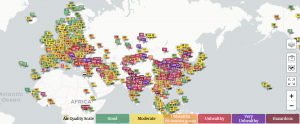https://waqi.info/#/c/31.537/62.471/2.2z
This figure depicts the Air Quality Data in the Western Hemisphere. The Air Quality index is based on the measurements of particulate matter, Ozone, Nitrogen Dioxide, Sulfur Dioxide, and Carbon Monoxide emissions. These points are set up to monitor the PM2.5 and PM10 levels and all measurements are based on an hourly reading for more than 10,00 stations.
There are many factors that contribute to bad air quality but the two most common factors are related to ground-level ozone and particulate matter. Particulate matter contains smoke, dust, dirt, soot, and salt in the atmosphere. Factors that contribute to particulate matter include vehicles, factories, fires, and human-activity that releases particles into the atmosphere. Although ground-level ozone is not directly emitted into the air, this ozone forms when nitrogen oxide emissions react with other volatile organic compounds when introduced to heat and sunlight. These released emissions include pollutants from industrial facilities and electric utilities, vehicle exhaust, and chemical solvents. Once the air quality reaches the unhealthy range, the AQI recommends that people with compromised health should stay indoors while Hazardous conditions state that everyone should avoid outside.


Logan, this is an interesting find. Great to have a global perspective and I like how they included and advisory aspect for people, a great resource.